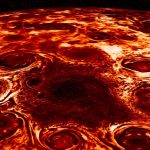NASA’s Juno spacecraft has been in orbit around Jupiter since 2016. One of its instruments is the ultraviolet spectrograph (UVS), which is primarily used to make ultraviolet images of Jupiter’s auroras. During the first four years of the mission, the UVS instrument has observed 11 transient bright flashes. These flashes look similar to lightning, but are located much higher in the atmosphere than the cloudy regions of Jupiter where lightning is generated. In a paper published in the Journal of Geophysical Research: Planets, researchers suggest that these are observations of transient luminous events in the gas giant’s upper atmosphere. In particular, they suggest that these events are elves, sprites or sprite halos, three types of transient luminous events that produce spectacular flashes of light very high in the Earth’s atmosphere in response to lightning strikes between clouds or between clouds and the ground.












